Sports
The boys volleyball boom in NC is here, and NCHSAA sanctioning could be sooner than you think
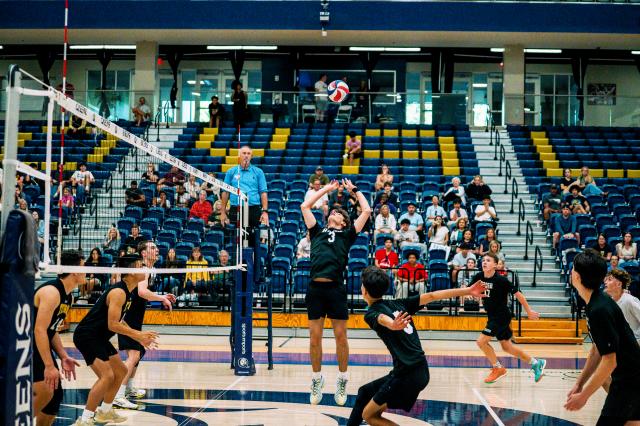
CHARLOTTE, N.C. — The sounds at Queens University of Charlotte’s Curry Arena were familiar enough, even if the sight was not.
Who in North Carolina can’t immediately hear the sneakers squeaking and the bellows from the stands and not think of basketball? Sure, the players jumped high, celebrated big moments, huddled for timeouts — but there were no hoops in store on this day.
This was boys volleyall, a sport that isn’t yet sanctioned by the N.C. High School Athletic Association but is in its ninth year of holding its own state championships.
It has experienced exponential growth and now boasts 135 teams across the state, public and private, with more lined up to join next year.
For the first time in its nine-year march towards sanctioning, the finals and semifinals were hosted on a college campus — fittingly at Queens, the only Division I athletics program in the state with a boys volleyball program.
There was enough interest in 4A to have its own bracket, where West Forsyth defeated Hough 3-1 (21-25, 25-22, 25-21, 25-18). All 3A, 2A, and 1A schools had their separate bracket, where Triangle Math & Science defeated Mount Pleasant in an epic 3-1 match (25-19, 34-36, 25-13, 25-10).
Previous iterations of the final bracket have split teams up in other ways, but this year’s was streamlined to fit what the NCHSAA does — separating them by size of school.
The changing of the playoff format is intentional, hoping to make it as easy as possible for the NCHSAA to adopt boys volleyball as the newest sport in the near future.
“It just reflected the growth of the game. We saw about a 50 percent split from 1A to 3A and 4A. We modeled that after lacrosse. I think anytime you can mimic something they’re already doing, it makes it easier for them to say yes,” Sarah Conklin, Director of the N.C. Boys Volleyball Association.
A humble beginning
Conklin played volleyball in college, representing the Charlotte 49ers. When her oldest son, Garrett Garcia, was in middle school, he asked if he could play too.
The natural answer was no. There was no boys volleyball team.
“Well, can’t we just start it?” he said.
That was the humble beginning of a nine-year passion project for Conklin, as she went to bat for a sport that didn’t exist. She found cooperation in Union County — at the middle school, high school, and even club levels — and the journey began in 2016-17 with four middle schools: Marvin Ridge, Weddington, Piedmont, and Parkwood.
Growth was slow for the first years — the pandemic stifled any early momentum — but the last four have seen exponential growth.
In 2022, only seven schools participated.
It more than tripled to 25 in 2023.
In 2024, it was up to 68.
This year, it was at 135 — more than 2,000 percent growth in four years.
Conklin has heard from dozens of athletic directors who don’t want to add another sport until it gets official sanctioning. She notes that while some schools have been enthusiastic in embracing the sport, others are far from it. Some teams did not practice or play on campus as a result.
“Our ADs, our wonderful teachers, are spread incredibly thin,” said Conklin, who now coaches her youngest son at Weddington. “I don’t begrudge an AD (for saying) ‘I don’t want one more thing to do in the spring.’ That’s why we try to make it as easy as possible.”
“We’re limiting the opportunity for so many young athletes to not only to get a college scholarship but to just be part of a team and find a place to belong,” she added. “The camraderie that boys volleyball brings is unlike any other because you have to work so closely.”
Falling in love with the game
The game has the same rules as the girls, but there are some noticeable differences.
There are those moments of togetherness after a big point, just like the girls game, but also a few stare-downs and mean-mugs on faces of players after a big point that are more remniscent of a basketball player getting an “and-one.”
The jump serves also stand out. While rare in the high school girls game, most of the Hough and West Forsyth players tossed the ball 20 feet into the air before timing their leap.
North Carolina has had club teams for awhile, and is home to some pretty good talent.
There are currently two North Carolina players on the U.S. National U19 team — Thomas Demps IV of Broughton (whose older sister Jade was N.C. Gatorade Player of the Year) and 6-foot-10 Grant Lamoureux of West Forsyth, who graduated in the fall semester to enroll at national power Pepperdine.
Conklin said that club interest hasn’t sparked high school interest (there isn’t yet a team at Broughton for Demps, for instance) but the reverse. Once players encounter the sport at a high school setting, they then seek out club options.
Not every team has a club player, but they also don’t need one.
Other sports backgrounds have made the transition to the game easier than it appears.
A wrestler might make a great libero, or a goalkeeper a great middle blocker.
But over everything else, a willingness to learn and improve is all that’s needed.
“There’s a lot of courage involved and vulnerability to learn a sport as a high school guy. A lot of guys have only been playing a few years — even if they play club — (so) they still remember what it was like to not be able to pass the ball with your forearm, because you don’t grow up doing that.,” Conklin said. “But they learn so quickly so as a coach it’s so rewarding because you have win after win almost every practice and they learn so quickly.”
Path to sanctioning
Conklin is on the board of directors of First Point Volleyball Foundation, which works to grow the boys’ game in a number of states. When a North Carolina school adopts the sport, she and her team offer to handle scheduling. There are also grants for first-year and second-year teams to help ease the transition.
This year, her team even calculated teams’ RPI to mimic how the NCHSAA seeds its brackets.
Everything is done to make a seamless transition into NCHSAA sanctioning, but it’s not as simple as just gaining popularity.
For a sport to be officially adopted by the NCHSAA, it must meet at least one of two participation thresholds for two consecutive years.
One of the two thresholds is if at least 50 percent of schools within a single classification offers sport. They hit that benchmark this year. Fifty-four of the 103 schools in 4A fielded teams.
One down, one to go.
However, the “50 percent of a classification” rule is getting phased out and, starting next year as the NCHSAA expands from four to eight classifications, the bylaws will have just the one remaining threshold: a sport must be played by at least 25 percent of all NCHSAA member schools to be sanctioned.
But good news: that should be met as well.
With 446 total NCHSAA members, the 25 percent threshold comes out to 111.5 schools. Already, eight schools have told Conklin they plan on having teams next year, which would bring the total to 113 — enough to meet a required standard for a second straight year.
Girls flag football, another sport on the cusp of sanctioning, has hit thresholds in back-to-back years but has other hurdles, like differences on field size and preferred season (spring or fall) among schools.
Volleyball has no such incongruity among its participants, which could make for quicker sanctioning.
Conklin hopes that both sports can make it across the sanctioning finish line.
She knows what volleyball has meant for her sons and her players.
“What I love is I’ve never had a guy step in my gym who doesn’t fall in love with the game,” Conklin said. “You almost have to keep them from playing so much.”
Copyright 2025 by Capitol Broadcasting Company. All rights reserved. This material may not be published, broadcast, rewritten or redistributed.
Sports
Texas A&M tops Kentucky for first NCAA volleyball championship: ‘We sent a warning shot out to the world’
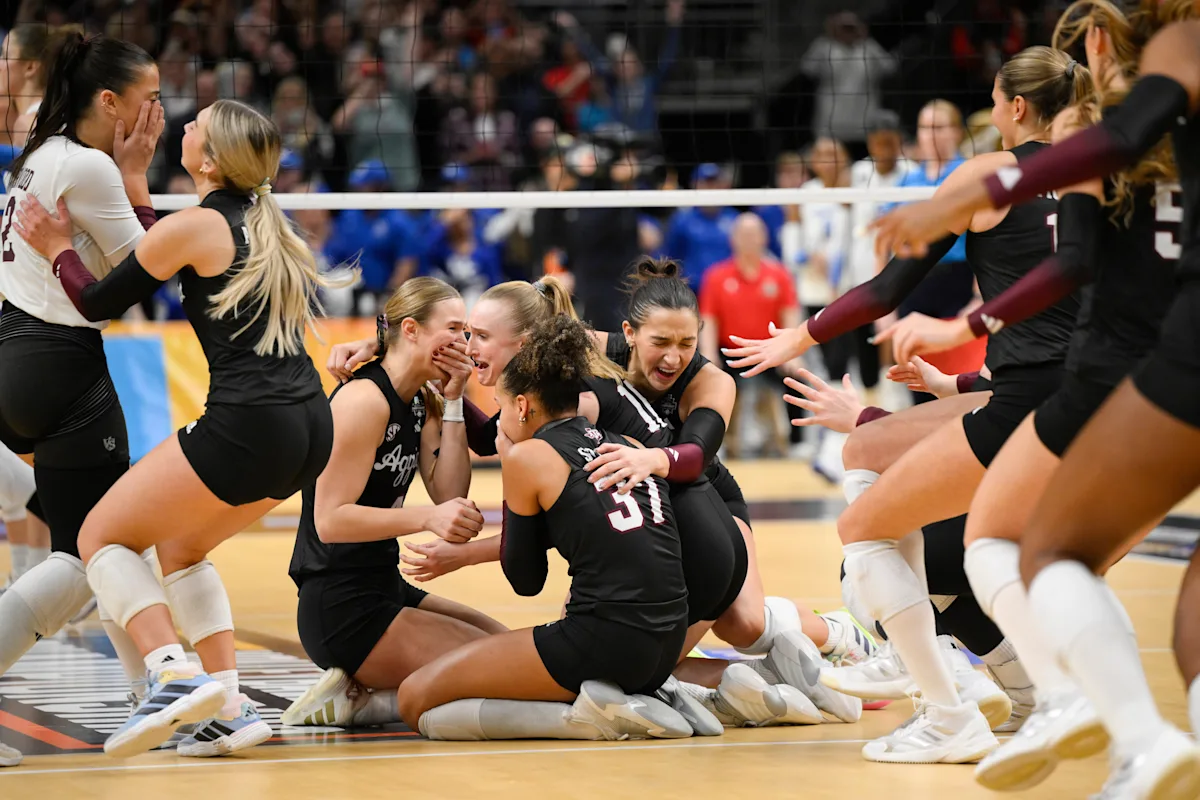
With Texas A&M up 24-20 in the third set of the NCAA women’s volleyball title match, Maddie Waak set the ball for Ifenna Cos-Okpalla. Though Logan Lednicky and Kyndal Stowers had played bigger games for the Aggies, it was Cos-Okpalla who got the call for the championship point.
She elevated and slammed the ball in between Kentucky’s defenders at the T-Mobile Center in Kansas City. With that kill, Texas A&M won an improbable national title, 3-0 (26-24, 25-15, 25-20).
Advertisement
“They’re putting on t-shirts behind me. I can’t believe it. I’m still a little bit in disbelief,” Aggies coach Jamie Morrison said to ABC after the game. “We sent a warning shot out to the world about what we’re about.”
Kentucky, the No. 1 seed, started out strong in the first set. They built a lead as big as six points before Texas A&M started chipping away, eventually winning the set, 26-24. With that momentum, the Aggies owned the next two sets. Lednicky was the star of the match with 7 kills, 11 digs and 2 blocks. With every point won, Texas A&M’s confidence grew.
Kentucky was the third No. 1 seed that Texas A&M — a third seed — beat on the way to the national title, and every win from the Sweet 16 on was shocking. First, the Aggies came back from 2-0 to pull the reverse sweep against Louisville. Next, Texas A&M had to face undefeated, No. 1 overall seed Nebraska in Lincoln. In what was the best game of the tournament, the Aggies beat Nebraska in five sets.
Advertisement
But their magic didn’t stop once the Aggies got to Kansas City. In the national semifinal, they swept No. 1 seed Pittsburgh, the first time the Panthers had been swept all season. And then in the first-ever All-SEC final, the Aggies came out victorious.
Unlike Kentucky, which won the national title in 2020 and has been one of the top teams in women’s volleyball for years, Texas A&M is a newcomer to volleyball’s elite. Though it had some good teams over the years that made it to the Elite Eight, this was the program’s first Final Four and their first national title.
Morrison took over the program in 2023, and held onto Lednicky and Cos-Okpalla. The Aggies turned the program around quickly, earning a bid to the tournament in 2023 and then making it to the Sweet 16 in 2024. This year, the Aggies went 29-4 and looked like a team on the brink. But with so many seniors, they had no time to waste and adopted the mentality of “Why not us?”
Lednicky, who played with the U.S. national team over the summer, was the heart of this team’s championship run, and the player who kept asking “Why not us?” Stowers’ comeback might be one of the best sports stories of the year. While playing for Baylor, she suffered concussions and medically retired from the sport. But after being medically cleared and deciding she had more to give to the sport, Stowers signed with Texas A&M and is now a national champion.
Advertisement
Morrison has built a program that is not only a national champion, but is in a great position to continue to grow volleyball in Texas. While he will lose seniors like Lednicky and Waak, he can now show off a championship ring while on the recruiting trail.
But figuring out who will play for the Aggies next season is tomorrow’s problem. Today, Texas A&M gets to celebrate how it defied the odds to win the school’s first-ever national title in women’s volleyball.
Sports
Kentucky vs. Texas A&M NCAA Volleyball Championship: How to watch, preview

Kentucky volleyball will look to win its second national title in five years on Sunday when it takes on Texas A&M in Kansas City.How to watchSunday’s game tips off at 3:30 p.m. at the T-Mobile Center. It will air on ABC.PreviewKentucky comes to the game on Sunday with the edge. The Cats are No. 2 overall in the NCAA ranking, and they have previously beaten the No. 6 Aggies 3-1 in October. That game, an A&M home game, saw then No. 3 Kentucky face off against No. 9 Texas A&M, but since that meet-up, the Cats have not lost a single game, and the Aggies are right behind them with a single loss to home state rival Texas. The Wildcats have won 27 straight games, 30-2 overall, with their last loss in September to Pittsburgh. Texas A&M comes in 28-4 overall, with a five-game win streak, after their loss to Texas destroyed their 11-game win streak.Kentucky is no stranger to the NCAA championship. The Cats snagged their first title in 2020 after they beat Texas 3-1 in Omaha. Texas A&M has not made an appearance at the NCAA championship but has finished in the top ten four times in the last five years, finishing in fifth place in 2024.
Kentucky volleyball will look to win its second national title in five years on Sunday when it takes on Texas A&M in Kansas City.
How to watch
Sunday’s game tips off at 3:30 p.m. at the T-Mobile Center. It will air on ABC.
Preview
Kentucky comes to the game on Sunday with the edge. The Cats are No. 2 overall in the NCAA ranking, and they have previously beaten the No. 6 Aggies 3-1 in October. That game, an A&M home game, saw then No. 3 Kentucky face off against No. 9 Texas A&M, but since that meet-up, the Cats have not lost a single game, and the Aggies are right behind them with a single loss to home state rival Texas.
The Wildcats have won 27 straight games, 30-2 overall, with their last loss in September to Pittsburgh. Texas A&M comes in 28-4 overall, with a five-game win streak, after their loss to Texas destroyed their 11-game win streak.
Kentucky is no stranger to the NCAA championship. The Cats snagged their first title in 2020 after they beat Texas 3-1 in Omaha.
Texas A&M has not made an appearance at the NCAA championship but has finished in the top ten four times in the last five years, finishing in fifth place in 2024.
Sports
Texas A&M volleyball beats Kentucky to win national title
Sports
NATIONAL CHAMPIONS! – Texas A&M Athletics
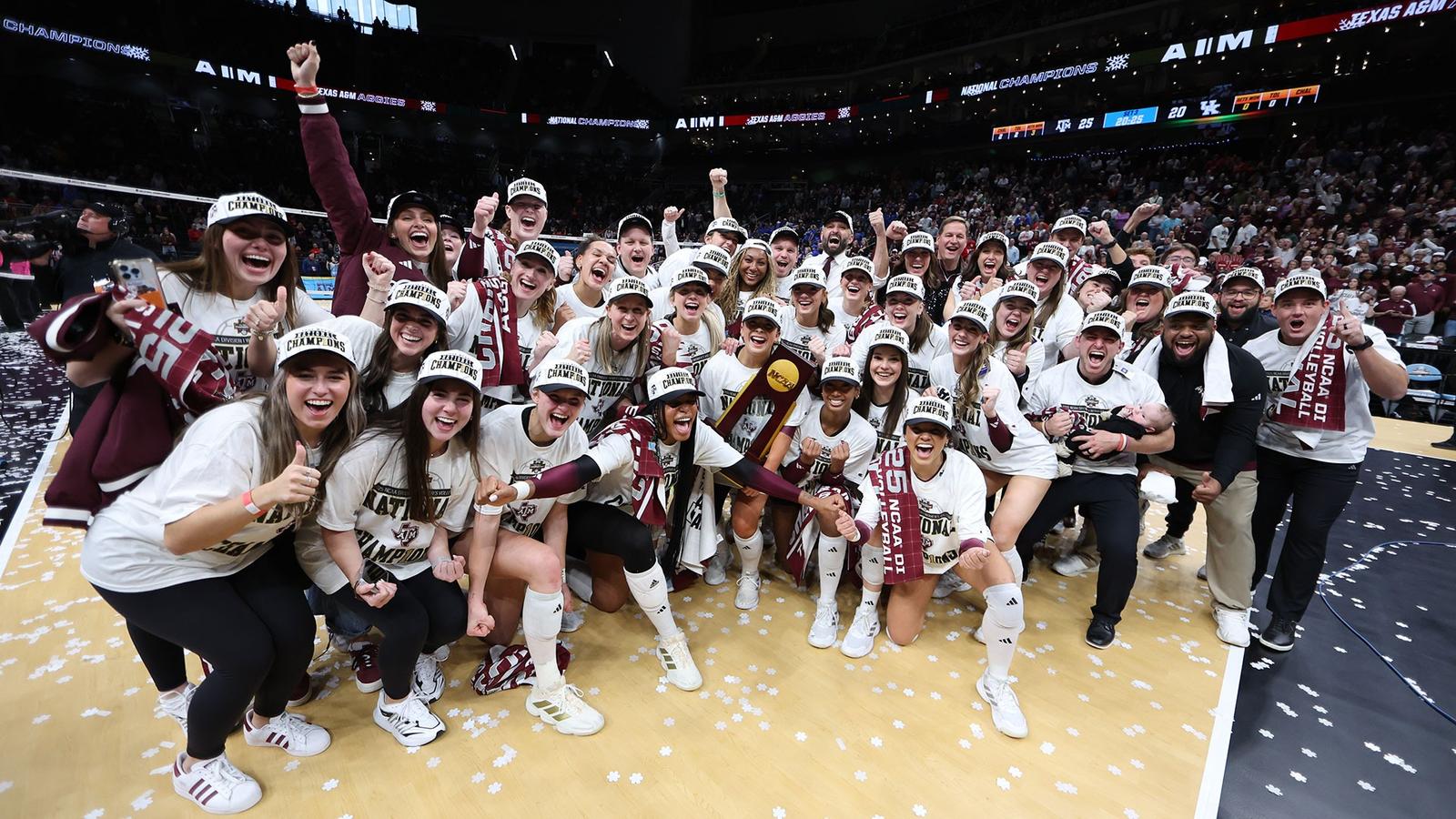
KANSAS CITY, Mo. – The Texas A&M Aggies overwhelmed the Kentucky Wildcats in the final two sets of a 3-0 (26-24, 25-15, 25-18) victory to claim the school’s first-ever NCAA Division I Women’s Volleyball Championship Sunday evening inside the T-Mobile Center.
Entering the tournament as the No. 3 seed in the Lincoln Regional, Texas A&M (29-4) completed a postseason sweep of three of the tournament’s No. 1 seeds, beating Nebraska (3-2) and Pitt (3-0) before dispatching of Kentucky (30-3). The last three teams the Maroon & White beat were a combined 93-6 before their respective seasons were ended.
The Aggies became the ninth team in the 45-year history of the NCAA Championship to sweep both of their Final Four matches.
The Maroon & White never trailed in the last two sets. The opportunistic Aggies took advantage of the Wildcats’ nine service errors and 16 attack errors.
Kyndal Stowers was named the NCAA Championship Most Outstanding Player. She capped off the tournament with a .304 attack percentage, 10 kills, six digs, two service aces and one block in the triumph over Kentucky. Ifenna Cos-Okpalla, Logan Lednicky and Ava Underwood joined Stowers on the All-Tournament Team.
Texas A&M claimed the first set despite not leading until 25-24. The Wildcats pounced on the Aggies in the first set for a 9-3 advantage. Kentucky led by six on eight more occasions, before the Maroon & White clawed back into the contest. An 8-2 run, featuring two kills each by Cos-Okpalla and Lednicky, tied the contest at 20-20. With the set seesawing, the Wildcats had its first set point at 24-23, but Stowers sandwiched two kills around a block assist by Cos-Okpalla and Maddie Waak for the smash and grab.
The second set was tied twice early before the Aggies broke away. Back-to-back kills by Lednicky and a service ace by Cos-Okpalla allowed Texas A&M to open a 5-2 lead. The Maroon & White suffocated the Wildcats with a 13-3 run to open its biggest lead of the set at 19-8. Kentucky would draw no closer than seven the remainder of the set.
After Kentucky opened the third set with a service error, Cos-Okpalla put aways two kills to start a 6-1 surge out of the gate. The Wildcats cut the deficit to 10-8, but 9-3 charge by Texas A&M widened the lead to 19-11. Big Blue was closed the gap to four at 24-20, but it was too little, too late as Cos-Okpalla uncorked a booming kill for the final point.
STAT LEADERS
Kills – Logan Lednicky – 11
Hitting Percentage (Min. 10 kills) – Kyndal Stowers – .304
Assists – Maddie Waak – 29
Aces – Ifenna Cos-Okpalla; Maddie Waak – 2
Digs – Ava Underwood – 10
Blocks – Ifenna Cos-Okpalla – 4
GAME NOTES
- Logan Lednicky recorded her 23nd-consecutive game with 10 or more kills.
- Ifenna Cos-Okpalla set the Texas A&M career record for blocks, wrapping up with 566. She also inflated her single-season school record to 199.
- Jamie Morrison joined John Dunning (first year) and Michael Sealy (second year) as one of three coaches two win an NCAA Division I Volleyball tournament in their first three years as a head coach.
- The Aggies beat all four of the No. 1 seeds of the NCAA Championship, beating Texas (3-2) in the regular season and Nebraska (3-2), Pitt (3-0) and Kentucky (3-0).
FOLLOW THE AGGIES
Visit 12thMan.com for more information on Texas A&M volleyball. Fans can keep up to date with the A&M volleyball team on Facebook, Instagram and on Twitter by following @AggieVolleyball.
Sports
Alumni Spotlight: Aviana “Avi” Goode ’20
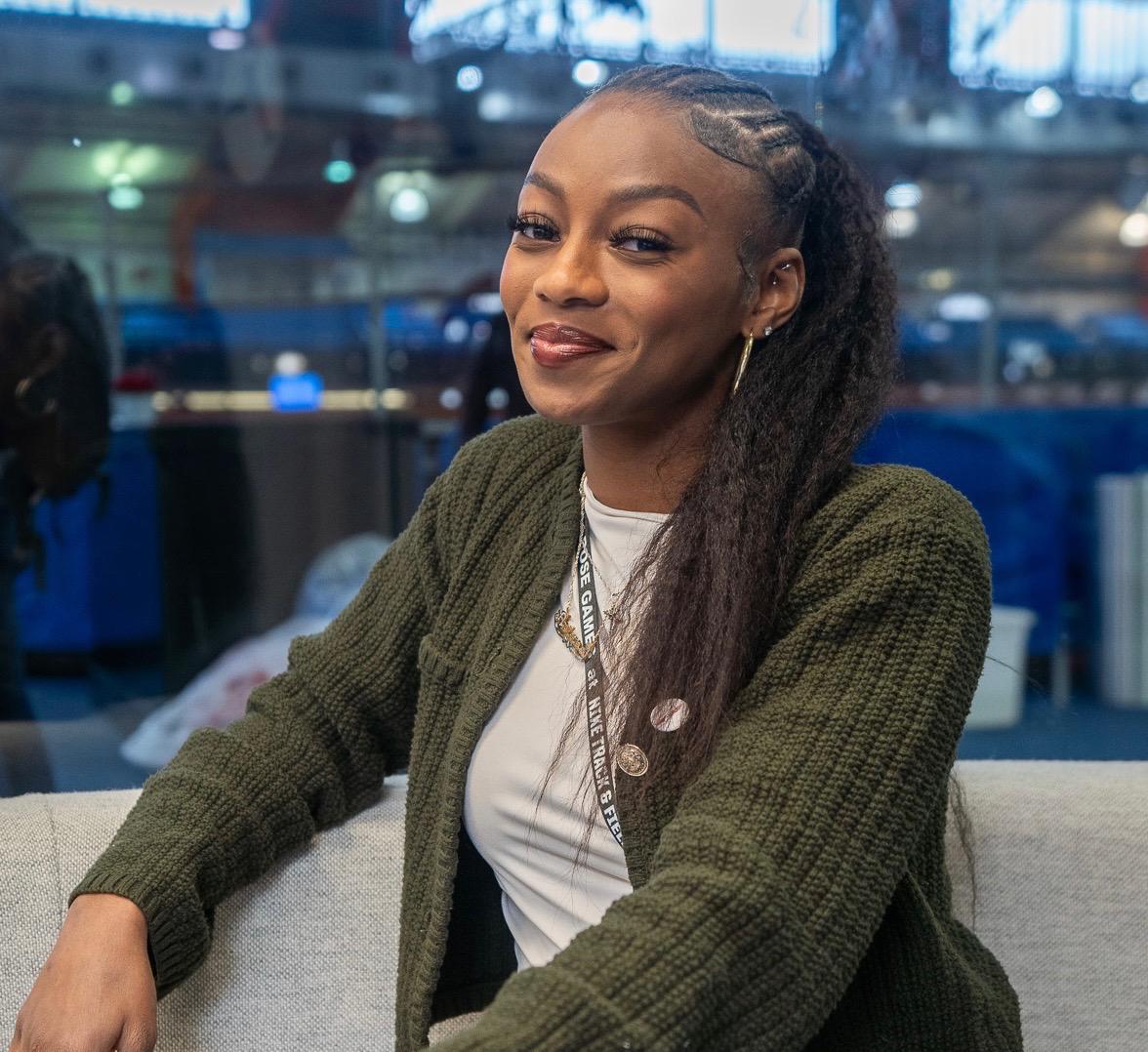
Track and Field
Aviana, also known as Avi, is no stranger to success on the track. Before turning 18, Avi had already won three state championships and earned multiple bronze medals, along with a silver, while competing for her high school track team — and even added a school record in the process. Her winning nature carried over to Syracuse where she balanced being a student and an athlete, studying Communication and Rhetorical Studies at VPA and Sports Revenue Management & Operations at Falk College. This balance paid off as she earned top-six finishes at the 2019 ACC Indoor and Outdoor Championships in the high jump. She continued to add to her long list of track achievements during her graduate transfer year when she competed for The University of Texas Rio Grande Valley (UTRGV) where she previously held the indoor program record for 60m hurdles and the outdoor record for the 100m hurdles and heptathlon. Although she no longer competes on the track, she has found a new way to stay involved with the sport she loves.
It was always Aviana’s dream to earn a trip to TrackTown USA in Eugene, Oregon. For those who may not know, TrackTown is a world-class track and field facility organizing events such as the 2015, 2022, 2023 USATF Outdoor Championships and the 2016, 2020, and 2024 U.S. Olympic Team Trials. Aviana’s dream to make it to TrackTown USA, also known as Hayward Field, came true when she was selected as one of four photographers to cover the 2024 U.S. Olympic Track and Field Team Trials as park of the Black Women Photographers and TrackTown USA creative team.

“It was surreal,” Aviana said. “My goal in life, in track and field specifically, was always to make it to Hayward Field. It was supposed to be as an athlete, but I guess God had different plans for me. I ended up there with a whole new lens, literally and figuratively.”
Aviana spent over a week at TrackTown shooting world-class athletes like Olympic champion and eight-time World Champion, Noah Lyles, Olympic long jump champion, Tara Davis-Woodhall, and even Olympian and World Record breaker, Sydney McLaughlin.

The unique part about the entire situation is that Aviana was just a newbie in the sports photography world at this point. She had started sports photography just two years prior to shooting on this world-class stage and had only shot one outdoor track meet before. Despite the lack of experience, Polly Irungu, founder of Black Women Photographers, loved her photos and style.
The opportunity to shoot the Olympic Trials allowed Aviana to grow tremendously as a person but also as a photographer. While covering the Olympic Trials, she noticed that not many women of color were working as creatives although the sport is predominately black. There were only five other creatives that were black women that she saw capturing the events at TrackTown. This realization inspired Avi to be a role model and a representation for young black women and women of color who want to step into the creative world. As a freelance photographer based in NYC, she continues to refine her craft, working with athletes, brands, and events to create high-impact imagery that resonates.
“Being a photographer allows me to go out there and still feel like an athlete. I can feel the emotion. I’m capturing everything to remember the moment and to show the love and passion for the sport that I think is the hardest sport in the world, Aviana said.
Stay connected with Aviana on Linkedin: Aviana Goode | LinkedIn & Instagram: @goode.flicks

Sports
Kentucky volleyball results, recap vs Texas A&M in championship match

Updated Dec. 21, 2025, 5:16 p.m. ET
The Kentucky Wildcats volleyball team needed one more win to bring home a national championship, but the Texas A&M Aggies were the better team on Sunday afternoon, and it’s they who took home the trophy after winning the match 3-0 (26-24, 25-15, 25-20).
It looked like the Wildcats were going to take control early. They jumped out to a 6-1 lead in the first set, and led big as play progressed. However, some good Texas A&M serves, and some bad Kentucky passing led to an Aggies comeback.
After that first set, it seemed as if the life drained out of the Wildcats. The Aggies dominated the second set. They blocked nearly every Kentucky kill attempt, and dug out the rest. The Cats had no answers, and they fell behind 2-0.
Set three got away quickly from the Wildcats as well. The Texas A&M defense stayed strong, and more importantly, their passing was immaculate, and led to easy points. They would wind up taking it 25-20 to get the sweep and win the national championship.
It was a tough end to the season for Kentucky. Unfortunately, in the biggest game of the year, they had their worst performance. However, credit Texas A&M, who saved their best for last.
Congratulations to Texas A&M on the win, and congratulations to the Kentucky Wildcats for the terrific season.
Texas A&M wins set three and the match
The Aggies were the better team today, and are the national champions.
And another Kentucky service error
Their ninth of the match makes it 21-15 Aggies.
Kentucky service error
It was their eighth of the match.
Domination
The Aggies have just been the better team today, and lead 19-11 in set three.
More unforced errors for Kentucky
Kentucky’s seventh service error makes it 13-9 Aggies.
Kassie O’Brien kill as Kentucky tries to stay in it
The Wildcats trail 12-9 in set three.
Kentucky in big trouble
They’re down 6-1 now.
Kentucky error begins set three
Three straight errors by the Wildcats have the Aggies down 3-0 in set three.
Kentucky hitting has to improve
The Wildcats had a negative hit percentage in the second set and they’re hitting just .067 in the match.
Aggies take set two
It was complete domination by Texas A&M in the second set. They lead 2-0.
Texas A&M dominating
The Wildcats have no answers right now. Every shot is either being blocked, or just misses. It’s 24-15 Aggies.
Hitting errors hurting Kentucky now
Back to back striking errors have the Aggies leading 14-7 now and it’s danger time.
Block party for the Aggies
Kentucky is getting nothing right now. It’s another block for Texas A&M and it’s 10-5 Aggies in set two.
Eva Hudson kill
Hudson crushes one to make it 8-5 Aggies.
Another block by Texas A&M
Kentucky is struggling to get shots over the net. The Aggies defense is dominating the match.
Aggies defense taking over
Texas A&M is digging out every kill attempt, and poor passing is still a problem. Kentucky trails 4-2.
Texas A&M scores first in set two
A long rally ends with an Aggies point to begin the second set.
Kentucky has to rebound quickly
The Wildcats blew a big lead in set one with bad passing and sets. They have to recover quickly now.
Texas A&M takes set one 26-24
Kentucky’s passing was bad down the stretch, and it cost them the first set.
Kentucky trails
Some questionable passing has led to easy points for the Aggies, and they lead 25-24.
It’s tied again
A bad set from Kassie O’Brien led to a point for Texas A&M, and a tie at 23.
Molly Tuozzo ace
It’s a big ace for Tuozzo to put Kentucky up 23-21.
Service errors returning
Kentucky now has 3 service errors in the first set.
The match is tied
Texas A&M gets a block and it’s now 20-20.
Eva Hudson stops the run
Hudson gets a shot down the line and ends the scoring run for the Aggies.
Kentucky calls timeout
The Aggies have scored four straight points and it’s now 18-16 Kentucky in set one.
Texas A&M making a run
They’ve scored 3 straight points to cut the lead to 18-15.
Brooklyn DeLeye with back to back kills
DeLeye is using terrific location shots to get points. It’s 17-11 Wildcats.
Asia Thigpen is off to a hot start
She has two blocks already, and adds a kill to make it 14-9 Kentucky.
Brooklyn DeLeye kill
From the back row, DeLeye gets a big kill to make it 13-7 Wildcats.
Asia Thigpen again
Thigpen gets her second block, and Kentucky leads 9-3.
Asia Thigpen block
It’s 6-1 Kentucky after Thigpen gets the big defensive play. The serving has been very good so far, and a big factor.
Kassie O’Brien makes it 3-0
The Wildcats have started fast, and lead early on.
Kentucky scores first
The first point of the match is scored by the Wildcats.
It’s time
Kentucky vs Texas A&M for the national championship.
Where to watch Kentucky vs Texas A&M
When to watch Kentucky vs Texas A&M
- Date: Sunday, Dec. 21
- Time: 3:30 P.M. ET
-

 Motorsports2 weeks ago
Motorsports2 weeks agoSoundGear Named Entitlement Sponsor of Spears CARS Tour Southwest Opener
-

 Rec Sports3 weeks ago
Rec Sports3 weeks agoBlack Bear Revises Recording Policies After Rulebook Language Surfaces via Lever
-

 Motorsports2 weeks ago
Motorsports2 weeks agoDonny Schatz finds new home for 2026, inks full-time deal with CJB Motorsports – InForum
-

 Rec Sports2 weeks ago
Rec Sports2 weeks agoHow Donald Trump became FIFA’s ‘soccer president’ long before World Cup draw
-

 Rec Sports2 weeks ago
Rec Sports2 weeks agoDavid Blitzer, Harris Blitzer Sports & Entertainment
-

 Motorsports2 weeks ago
Motorsports2 weeks agoJR Motorsports Confirms Death Of NASCAR Veteran Michael Annett At Age 39
-
Sports2 weeks ago
Elliot and Thuotte Highlight Men’s Indoor Track and Field Season Opener
-

 Motorsports2 weeks ago
Motorsports2 weeks agoRick Ware Racing switching to Chevrolet for 2026
-
Sports2 weeks ago
West Fargo volleyball coach Kelsey Titus resigns after four seasons – InForum
-
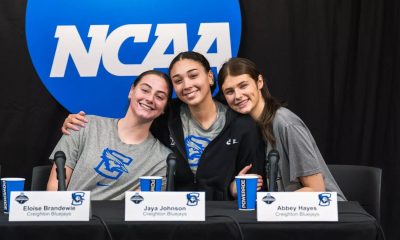
 Sports1 week ago
Sports1 week ago#11 Volleyball Practices, Then Meets Media Prior to #2 Kentucky Match









































